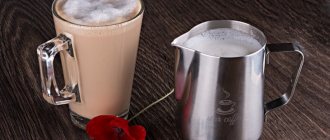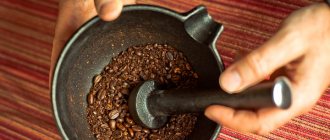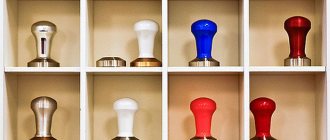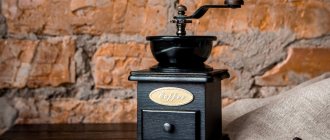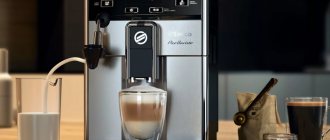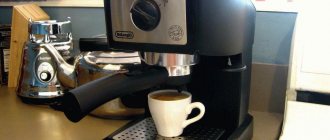Features of a burr coffee grinder
To prepare oriental coffee, it must be very finely ground. For these purposes, the first manual burr coffee grinder was invented in the 15th century. Inside such a device there are two millstones that grind coffee beans into powder.
A burr coffee grinder is designed for fine grinding.
The distance between the rings can be adjusted and you can get coffee of different grinds (from coarse to finer). Coffee grinder parts are made of cast iron or ceramics. Cast iron ones are strong and durable, while ceramic ones retain all the qualities and aroma of coffee well.
Form
Modern manual and electric coffee grinders use flat or conical burrs. The first are the classic standard. Some models have both types: flat-conical.
Coffee grinders are manual and electric.
Design
Flat millstones are two steel discs of the appropriate shape with one-sided notches (cutting edges) applied around the circumference of the disc itself. There are large holes in the center of both discs. Through a hole in the upper millstone, coffee beans enter the coffee grinder. The hole in the lower disk is used for attachment to the motor shaft.
During operation, one of the millstones is fixed, while the second rotates, grinding the grains.
Flat burrs in a coffee grinder are used to coarsely grind coffee beans.
The holes for attaching the discs themselves directly to the coffee grinder body are located around the circumference. The electric motor starts the grinder grinder (hundreds of revolutions per minute), and very fast rotation occurs.
At the initial stage of grinding, the grains are crushed into large particles. This happens thanks to the blades located around the circumference of the millstones of the internal hole. After this, large particles of coffee beans move to the outer edges of the discs, where they are further crushed by small blades located on the outer circumference.
Manual coffee grinders use flat burrs.
During the grinding process, when the coffee is approximately equal to the distance between the outer edges of the burrs, it is pushed out of the side slot between the discs into a container or coffee brewing unit.
The most common and most progressive millstones on the market are conical millstones. They consist of a cone - this is a lower rotating disk and a funnel with cutting notches. Unlike flat millstones, these millstones have increased productivity and low noise levels. The ability to lower the speed allows you to reduce the heating of the coffee beans during the grinding process, which preserves the aroma much longer.
Conical burrs are used in coffee grinders more often than flat ones.
The principles and sequence of operation of conical millstones are the same as for flat millstones. The coffee beans are ground between the working surfaces as the lower disc of the coffee grinder rotates. Already properly ground coffee is pushed out at the bottom of the millstones.
Material
Coffee grinder burrs are most often made of high-carbon steel. In devices intended for heavy loads, parts are coated with various protective coatings that reduce wear. Even hardened, durable steel is subject to wear, but when titanium is applied, the millstones will become dense, smooth and will last for quite a long time.
The grinders in the coffee grinder are made of titanium, which makes them last longer.
Such disks are used in professional machines for large volumes of work, and accordingly the device is expensive.
Although ceramic wheels are considered hard and retain the aroma of coffee beans, they are very sensitive to the ingress of excessively hard particles into the grinding zone; when overheated, they collapse and crack.
The material used to make millstones is varied. There are titanium, ceramic, stainless steel.
The best solution for 2021, according to experts, is the combination of ceramics with corundum - a durable, environmentally friendly alloy that can grind grains of any size and hardness. It is not afraid of dampness, water, rust, and does not absorb foreign odors.
The cheapest, with many positive reviews from consumers, are stainless steel millstones. They are quite wear-resistant, have average durability, and are great for regular use.
The simplest millstones for a coffee grinder are made of stainless steel.
Millstone type
Millstones in coffee grinders are divided into 2 types:
- Plane-parallel - they consist of 2 washers, tightly adjacent to each other with sides with special notches. The process of grinding coffee beans is simple - as soon as the grain falls into the gap between the washers, it is ground when the size of the crushed particles becomes smaller than the distance between the two millstones and they are thrown out of the millstones.
- Conical - represent 2 cones that are located inside each other. The outer cone is stationary, while the inner cone rotates rapidly. Grinding of grains with this type of millstone occurs slowly. The coffee beans are caught between the outer and inner cones, flow down and are ground into powder.
What influences the type of millstone?
The type of millstone installed in the coffee grinder affects the time spent processing beans and the operating period of the device.
- Plane-parallel millstones operate at higher speeds and grind grains faster, but they also have a significant drawback - unlike conical millstones, their working life is several times less, which means they will need to be frequently replaced with new ones. Another drawback is the high noise level when operating such a coffee grinder.
- Conical millstones work slower than plane-parallel ones, but they have their own number of advantages:
- The coffee grinder works quietly.
- Coffee beans are not burned.
- The disadvantages of coffee grinders with conical burrs include their high cost.
Which type of millstone is best?
When choosing a coffee grinder, you should give preference to conical millstones, despite the fact that its cost will be an order of magnitude higher - during operation it will become clear that the money spent is completely justified.
Advantages and disadvantages
Now you can take a closer look at the specifics of the operation of each type of device separately, finding out what a burr coffee grinder is and how comfortable this equipment is for everyday use.
Manual coffee grinders are more budget-friendly.
Manual burr coffee grinder
A hand mill has metal or ceramic millstones, the grinding fineness of which is regulated by a special screw. The first millstone of the crushing apparatus rotates with the rotation of the coffee grinder handle, the second remains firmly fixed. The mechanics are durable, work independently of electricity, do not burn beans and allow you to get aromatic coffee. Significantly cheaper than electric ones. Indispensable for outdoor trips.
The disadvantage of a regular manual coffee grinder is that you need to spend time and physical effort of 5 minutes or more to grind coffee for one serving. Therefore, this unit is not applicable, for example, for an office.
In a manual coffee grinder, a special screw is responsible for the fineness of grinding.
Electric burr coffee grinder
Popular brands offer more efficient electric burr coffee grinders that are distinguished by high-quality and uniform grinding. They do not require any effort or energy; you just need to press a button and the device will do everything for the user. This is a great solution for morning coffee or visiting guests.
It is very important that beans ground in burr-type coffee grinders are suitable for brewing in carob and other coffee makers and types of coffee machines.
It has a more modern design, differs from manual grinding in higher quality.
Varieties
There are two types of burr coffee grinder for home:
- The first type is an automatic device that minimizes the process of monitoring cooking. All you have to do is pour grains into such a device and press a button, the device will do the rest itself. The downside is that you will still have to take part in pouring the grinding into the tank, besides, the more parts and circuits there are in the device, the greater the chance that something will break in it.
- The second type of burr coffee grinder for home is manual. Here everything is much simpler. You pour the beans into a container and grind them yourself. In some cases, if the grip on the handle is uncomfortable (or, for example, the lever has insufficient resistance), this can take time and require a lot of effort. However, if you need to prepare one or two cups of coffee, it will not take much time. The advantage of this type of coffee grinder is that you can take it with you everywhere, even to places where there is no electricity.
It should be noted that a manual coffee grinder has more of a decorative function and is much less common; it can often be seen in a gift store, while automatic burr coffee grinders are sold in home appliance retail stores almost everywhere, the reason for this is their versatility.
In addition to minimal intervention in the grinding process, you can also take advantage of the coffee maker function that comes with an automatic coffee grinder.
This is very convenient, because you don’t have to figure out by eye how much coffee to grind, the container for grinding is always adjusted to the size of the tank for preparing the drink. Such devices are universal, combining the functions of two devices at once and therefore cost more than manual ones. Millstone coffee grinders for the home with a coffee maker function are offered by several well-known brands. The choice is quite large (both in terms of capabilities and price range).
The power of such devices can vary from 200 to 350 W, depending on the capabilities of the coffee grinder. Particularly advanced models have a function for selecting the amount of grinding, which is extremely convenient; however, they usually cost an order of magnitude more. Premium devices (all-in-one) can grind beans according to the number of selected cups of coffee. However, if a person has been preparing the drink for quite a long time, then he can easily determine by eye how many beans should be poured into the container to prepare one or two cups of coffee. So the need for such a function is quite conditional and will appeal more to a connoisseur of all kinds of technological innovations.
For home use, most likely, a simple burr coffee grinder with a minimum of capabilities and a power of 200-250 W is suitable. This is quite enough to prepare any amount of grinding.
The working principle of burr coffee grinders
A distinctive feature is the presence of two containers. One is filled with grain, the other is filled with already ground coffee. This is very convenient when grinding small portions.
Burr coffee grinders allow you to achieve uniform grinding. In some models, you can select the grind size necessary to obtain a certain taste and aroma inherent in the characteristic varieties of coffee. The selection of parameters is made on the touch panel.
The principle of operation of a coffee grinder is to grind beans for further use.
The operating principle of this type of coffee grinder consists of the following steps:
- Whole coffee beans, falling into the millstones, are ground during the operation of the coffee grinder mechanism and turned into powder of varying densities;
- adjusting the distance between the rings allows you to choose a larger or finer grinding particle size; this is very important, since each type of coffee has its own optimal density, which affects the subtleties of the characteristic taste and smell.
An electric coffee grinder has several grinding modes.
Caring for your manual coffee grinder
After grinding coffee, when many people look at a manual coffee grinder, the question often arises: what is the best way to wash it? Convenient cleaning of all internal elements greatly simplifies the maintenance of the device. The main components that need to be cleaned after completion of work: the millstones, the bean container and the container for the finished coffee powder. Each coffee grinder needs to be cleaned differently: this is where the instructions for use will come to your aid.
The millstones cannot be washed under running water; they only need to be thoroughly cleaned with a small brush and wiped with a cloth.
Main characteristics when choosing
When choosing a coffee grinder, the main factors are the millstones, their type and material, grinding adjustment, the presence of a timer, containers, ease of cleaning the device and price.
Power
The engine power of the device is of great importance - because it affects performance and durability. The numbers for home coffee grinders are from 100 to 170 W. For heavily roasted and strong beans, professional devices with ratings from 150 to 180 W are used.
When choosing a coffee grinder, you should take into account the power, grinding modes, and additional options.
Limitation of grinding time and amount of powder
These characteristics are adjusted using a timer. It is set to a specific number of seconds for a specific number of cups of coffee being prepared.
Timers can be mechanical or electronic. Which choice is better is a matter of principle. It all depends on taste and financial capabilities. Models with an electronic timer are more expensive.
Everyone chooses a coffee machine for themselves.
Type of millstone
Millstones are made of stainless steel, ceramics, alloy (ceramics + corundum) stone. The material from which the rings are made affects the durability, uniformity and quality of grinding of coffee beans, as well as its taste.
When choosing millstones, it is worth buying higher quality materials; their shelf life depends on this.
An important point when choosing millstones:
- the durability of metal discs is comparable to grinding 250-500 kg of coffee;
- When used correctly, ceramic rings can grind up to 1000 kg of coffee.
After these resources have been exhausted, it is necessary to replace the millstones with new ones by ordering them at the service center. Otherwise, the coffee grinder will not be able to please you with the excellent grinding quality, which in turn will affect the taste of the drink.
Electric coffee grinders work faster and better than manual ones.
Millstone material
Burr coffee grinders are very rare and expensive. Mostly they contain stainless steel rings. What millstones are still used in coffee grinders are described at the beginning of the article. In any case, the choice remains with the buyer.
Usually, the materials chosen for coffee grinders are expensive and durable.
Adjusting the grinding degree
This parameter directly depends on the client’s preferences. When preparing in a French press, the coffee particles must be fairly large. When brewing espresso, medium grind particles are suitable. If the client loves oriental or Turkish coffee, the lightest type (dust) is best.
It is very important, if possible, to understand in the store all the intricacies of the work from coarse to fine grinding. Therefore, you should not purchase the device via the Internet. It is worth looking for the most convenient and simple adjustment option. An excellent choice would be to purchase a coffee grinder with precision burrs.
There is no adjustment of the degree of grinding in manual coffee grinders.
Easy to clean
Few buyers pay attention to this criterion, but they are well aware of it some time after the purchase. Some people don't even realize that cleaning a coffee grinder can be a very difficult task. They mainly clean millstones and containers for beans and coffee powder.
The coffee grinder needs to be cleaned regularly.
Sequence of the cleaning process.
- You need to unscrew the bean container, remove the powder container and rinse.
- Unscrew the screws that secure the millstones, carefully remove them and clean them with a brush and wipe with a napkin.
- Carefully reassemble everything in reverse order.
When purchasing, you can ask the seller to help - show the cleaning process. This way you can see how difficult it is.
Important! Do not wash the millstones with water!
Coffee lovers prefer to have a cup of the brewed drink for breakfast.
Additional options
When choosing a device, it is advised to pay attention to the following details.
- The capacity of the containers and the material from which they are made. The best option is glass. They are not static and do not absorb odor.
- Function of automatic shutdown of the device motor when clogged.
- Locking the device when the cover is open.
- Motor protection and device shutdown in case of overheating and overload.
- Slotted legs are a very useful little thing that will help secure the equipment while working so that it does not move around the table.
- Templer - for compacting “pods” (so-called coffee tablets).
- Cord compartment.
- Cooling Fan.
- Increased sound insulation.
Manual coffee grinders have an interesting and intricate design.
Limitation of grinding time and amount of powder
Using a special timer, the user of the coffee grinder can independently set the time spent on grinding and the amount of coffee powder obtained at the exit.
What to look for?
Timers in devices can be of two types:
- Timer for setting the required number of seconds;
- Timer for selecting the number of cups of coffee.
The type of timer installed depends on the specific model of the device and its manufacturer.
Also, types of timers can be mechanical or electronic; there is no fundamental difference; in this matter, be guided by your desires. The second option is more modern, and is found in almost all machines. Which have been released over the past 2-3 years.
Useful tips for choosing
To summarize, we can note some features that you need to pay attention to when choosing a coffee grinder:
- Millstone type;
- the material from which the rings are made;
- engine power;
- volume of containers;
- ease of cleaning.
Research the market before purchasing a coffee grinder.
For espresso coffee lovers or those who like to make coffee in a geyser coffee maker, a burr coffee grinder will be an indispensable assistant. Some of them have 14 grind levels and hold 250-300 grams of coffee!
Containers for grains and finished powder
Standard containers for pouring coffee beans usually hold from 150 to 350 grams. Containers for powder have a volume from 100 to 250 g.
The material from which such containers are made is:
- Metal;
- Stainless steel;
- Glass.
The material of the containers and their capacity do not affect the operation of the device. Only the aesthetic appearance of the coffee grinder and ease of use depend on them.
Which option is preferable?
Glass is rightfully considered the most convenient and practical material. It is easily cleaned of coffee, does not electrify, is not subject to deformation, and also does not absorb color or odor. The only drawback of such containers is their fragility.
When choosing the volume of such bowls, try to fall into the range from 100 to 180 grams. There is no point in taking large containers, since the coffee will dry out before you have time to completely use it up.
The best inexpensive models of millstone devices
Below we will look at several burr coffee grinders that are best for home use. The presented options will fit perfectly into any style and interior of the kitchen space.
De'Longhi KG 89
The device is from a trusted manufacturer from Italy, which guarantees a high level of product quality and durability. The device has a square body made of stainless steel and a stepless dosage regulator.
The device is equipped with a special place for the cord, which makes it compact. A distinctive feature of the model is the cylindrical steel millstones, thanks to which the grinding of grains is regulated.
Pros:
- efficient grinding system;
- many degrees of grinding;
- the presence of anti-slip feet;
- two plastic containers;
- compactness.
Minuses:
- uneven grinding of grains;
- works noisily;
- there is a high probability of burning the beans;
- coffee sticks to the sides of the container.
As an additional option, there is a regulator for the number of cups - it can be controlled by a rotating knob, which is located on the end of the device.
Melitta Molino
An excellent model that is perfect for grinding coffee to the desired degree. To understand the distinctive features of the device, you should consider its positive and negative sides.
Pros:
- spacious capacity;
- fast grinding;
- it is possible to adjust portions depending on the number of cups;
- 17 grinding modes;
- automatic shutdown to protect against overheating;
- ease of management and maintenance.
Minuses:
- when grinding finely, the raw material sticks to the bowl;
- There is no dosage for 1 cup.
An important nuance is that the grinding disc is removable, so it can be sharpened.
Kitfort KT-717
Several dozen new devices have appeared in 2021, and each has positive and negative criteria. This model is distinguished by its affordable price and metal millstones made of durable carbon steel.
Pros:
- Grind sizes from 2 to 14 cups are available;
- 14 grinding levels;
- ergonomic design and intuitive controls;
- quiet;
- high grinding speed;
- easy to disassemble;
- easy to clean, brush included.
Minuses:
- the container is not hermetically sealed, the powder flies in different directions.
A nice feature will be a compartment for storing the cord - this is especially important in small kitchens, where every centimeter of free space is important.
Options
When choosing a burr coffee grinder, you should pay attention to additional features that do not directly affect the grinding quality, but make operation easier.
In large bags of coffee beans you can find small stones, sticks, and hard objects. Getting between the millstones, they jam the mechanism. If a burr coffee grinder has an automatic shutdown function when clogged, this will allow you to save the burrs in force majeure circumstances. Also, the model must have an active function to block operation when the cover is removed or not tightly closed. An additional overheat protection option will shut down the engine when overloaded and will not allow it to start until it cools down.
When choosing a burr coffee grinder, pay attention to those additional options that are important to you.
For more convenient dosage, the kit may include a measuring spoon that holds 7 g of coffee powder. This amount is enough to prepare one 30 ml serving of espresso. The dispenser can also be built into the coffee grinder mechanism.
Some models have increased noise insulation and are a little easier to operate than other devices. And if the case is equipped with a compartment for the cord, then the wire will not get in the way, especially if it rewinds automatically.
If the device is equipped with a cooling fan, then the risk of overheating the grains during grinding is reduced. But this option is found on expensive burr coffee grinders. But any model must have rubberized legs: this prevents the device from rolling off the table during operation.
Pay attention to how easy it is to clean the device. When purchasing, ask the seller to show you how to disassemble the device for cleaning and put it back together. It is easiest to care for mechanisms with removable containers.
Adjusting the grinding degree
Each electric coffee grinder has the ability to adjust the grind fineness. Usually it is 8–16 degrees. The indicator is determined by the distance between the millstones: the smaller it is, the finer the grind.
To change the degree, in some coffee grinders you just need to turn the ring at the bottom of the bean bowl. In more complex devices, you will have to unscrew the nut of the inner cone, move it to the required position and screw the nut back. In any case, before setting the grind, you need to remove the grains.
In addition to the degree of grinding, its uniformity is also important. Conventional coffee grinders, in addition to particles of a given size, also produce a certain amount of smaller fractions. If a coffee grinder says “precision burrs,” it means it produces a highly precise grind that will produce many more uniformly sized pieces than coffee grinders with simple burrs.
The amount of ground mass is controlled by a timer. This factor does not affect the degree and quality of grinding. The timer can count the time required to prepare a portion of the grind, or the amount of ground coffee. In the latter case, you simply set the number of cups, and the machine automatically calculates the portion.

